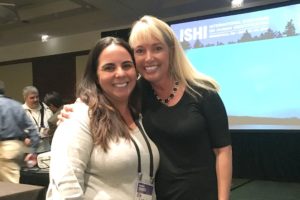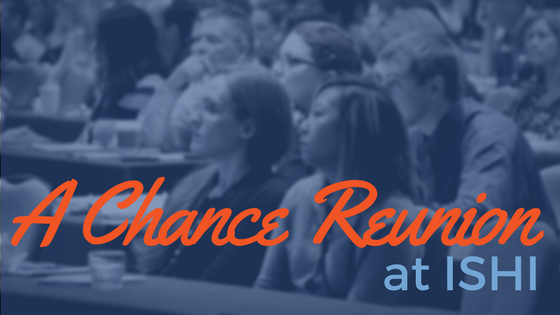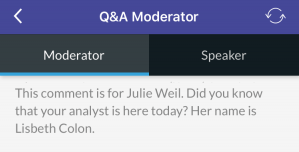Written by: Karen Burkhartzmeyer, Promega Corporation
It played out in front of a packed hotel ballroom of some 800 people at last year’s International Symposium on Human Identification (ISHI) in Minneapolis: the unexpected reunion between the survivor of a brutal serial rapist and the forensic analyst who found the DNA that led to a conviction in the case. Julie Weil had just told the terrifying story of her 2002 kidnapping and unthinkable repeated rapes in front of her two young children, emphasizing how the discovery of DNA evidence “saved her life.” At the end of panel discussion Q&A, the moderator, sounding surprised and frankly a bit unsure, read aloud a question she’d just received from the audience via the Crowd Compass app:
Onstage, Julie gasped and looked into the crowd. Audience members craned their necks as hands went up on one side of the darkened room, pointing to Lisbeth Colon, who waved and then slowly stood. Within seconds, Julie ran off stage toward Lisbeth and the two women embraced and shed tears. More than a few audience members did too, and everyone broke into applause. After all, ISHI attendees know that DNA science changes lives, but this was undeniable proof of it.
“For me, being able to meet the analyst in my case and give her a hug was one of the highlights of the past few years,” says Julie, who now works as a tireless advocate for rape survivors through her Not Just Me Foundation. “So much of my case hinged on the DNA evidence and the competent testimony of my analyst that I truly feel like she saved the day and, in some ways, our lives by helping get the conviction.”
Neither woman knew the other would be at ISHI. Julie was sharing her story as part of a panel discussion about the challenges of overcoming the sexual assault kit backlog. Lisbeth had left forensic DNA for a time after Julie’s case and had only recently returned to begin a new role training other DNA analysts at the National Forensic Science Technology Center in Largo, Florida.

“ISHI was the first professional meeting I attended since I returned to the field,” says Lisbeth. “Being able to be there for Julie’s presentation was amazing. It was very moving to me to know that my work helped her during this very difficult time. As a DNA analyst, I always hoped that the work I did actually contributed some good in my community. She confirmed that it did, and that in my new role I can help others be able to do the same in their communities.”
The story of the chance meeting even made it to the pages of People Magazine a few weeks after ISHI, showing a national audience how vital DNA evidence and the analysts that find it are in the journey to justice for survivors like Julie.
“Society hears a lot about DNA in the media but stories about actual analysts and the important work they do rarely makes the news,” says Julie. “After the article came out, I received messages from other survivors around the country on my website about how they wish they could thank the analysts in their cases. I also received a couple messages from rape survivors who wished they had reported their attacks, sharing with me how hard it often is for people to come forward and report the crime. The article renewed their faith in the system and humanized the science of DNA for them.”
Many people reached out to Lisbeth as well, including other analysts who said the story validated what goes on in forensic labs every day. “It felt great to know that many of the analysts feel motivated to charge on with the work we do.”
Chance Reunion at ISHI Proof of Life-Changing Power of DNA Science Share on X
That work can be frustrating at times but also deeply rewarding, requiring persistence and skill. For instance, DNA evidence from Julie’s 2002 case in Miami, Florida had been almost impossible to find. The attacker had shaved his body hair, burned off his fingerprints and used other means of destroying genetic material. Julie was examined by a SANE nurse just hours after the attack, yet no DNA was found. Police found absolutely no evidence in Julie’s van, despite her attacker having been with her and her children all day in the vehicle. Julie was devastated.
“The feeling of despair I already had as a victim just amplified, because now, who is he?” says Julie. “I have no evidence. I live in a city of three million people… and he could be anybody.”
But 48 hours later, Julie received a call that would give her hope. “They said, ‘the DNA lab went over your clothing with a fine tooth comb. They found a teeny tiny speck of DNA on the inside of your shirt.’ Which is ironic because I didn’t have my shirt on for 99% of that day.”
Lisbeth was the analyst who decided to test the inside part of the neckline where a shirt, while being taken on and off, may brush up against one’s lips. And that’s exactly where she found the only DNA in the case. That evidence led to the arrest months later of Michael Siebert, and eventually to seven consecutive life sentences for the man dubbed Florida’s “Day Care Rapist”.
Some (author of this post included) have dubbed Lisbeth a “rock star” for her role in the case, but she is quick to dismiss any such description, saying she just really loves her job and great things happen when you take pride in what you do.
But Julie, for one, may agree with the characterization. The day before participating in the panel discussion at ISHI, she sat down for an interview about her experience and her advocacy work. Even then, and without knowing Lisbeth was in attendance at the symposium, she expressed her deep gratitude to those in the forensic DNA field.
“You always wonder, every time you tell the story, does it make a difference? Is it going to impact people? I just need the people in the DNA community to know what they do is so important, on a personal level. It literally gave me the keys back to my life… to be able to not walk around in fear, and to get closure. And that’s what I want for everyone. And that’s what everybody deserves. The closure that comes from something like that is not a myth. It’s a real thing. I will be forever indebted to the lab in Miami, to the police officers and to my prosecutor for giving me the closure I needed to finally get up off the floor of my van and put my life together and now go out and advocate for others.”
You may also like:
The State of the Sexual Assault Kit Backlog in the United States pt 1
The State of the Sexual Assault Kit Backlog pt 2
Julie says having the opportunity to share her story at ISHI with hundreds of forensic DNA professionals gave her a sense that the pain her family had gone through had a purpose. “When a survivor gets up and shares their experience it often has a dual outcome: it provides special insight for the audience and a little bit of healing for the person doing the speaking.”
Since ISHI, Julie has been busy with her advocacy work through Not Just Me, speaking several times about issues relating to sexual violence and DNA testing. In November, she had an incredible opportunity through a project with the US State Department and the International Association of Chiefs of Police (IACP) to travel to Cairo, Egypt and share her message. As a result, real change is now taking place in Egypt including the opening of 24/7 rape crisis centers in Cairo and Alexandria.
“That trip was tangible proof for me that science and justice have universal importance in providing closure to people touched by crime,” says Julie.
Julie says she will continue to speak about the importance of advancing DNA technology, along with the need for comprehensive testing of rape kits, to anyone who will listen. She applauds conferences like ISHI that foster collaboration and scientific advancement for professionals in the DNA forensics field, allowing for more real-life outcomes hers.
“My story would have had a completely different ending without the closure that DNA provided,” says Julie. “I am so grateful. Hopefully I will see many of you out there as we ‘fight the good fight’”.
WOULD YOU LIKE TO SEE MORE ARTICLES LIKE THIS? SUBSCRIBE TO THE ISHI BLOG BELOW!



